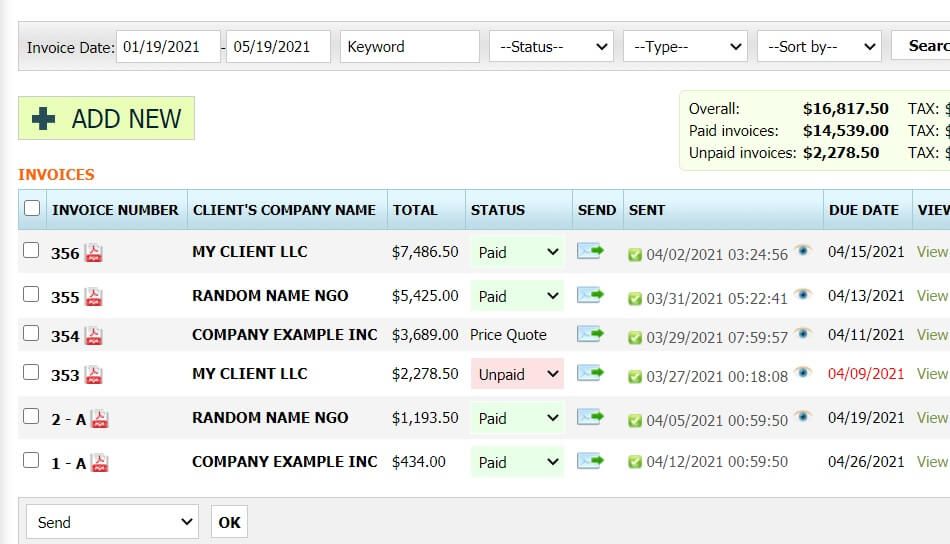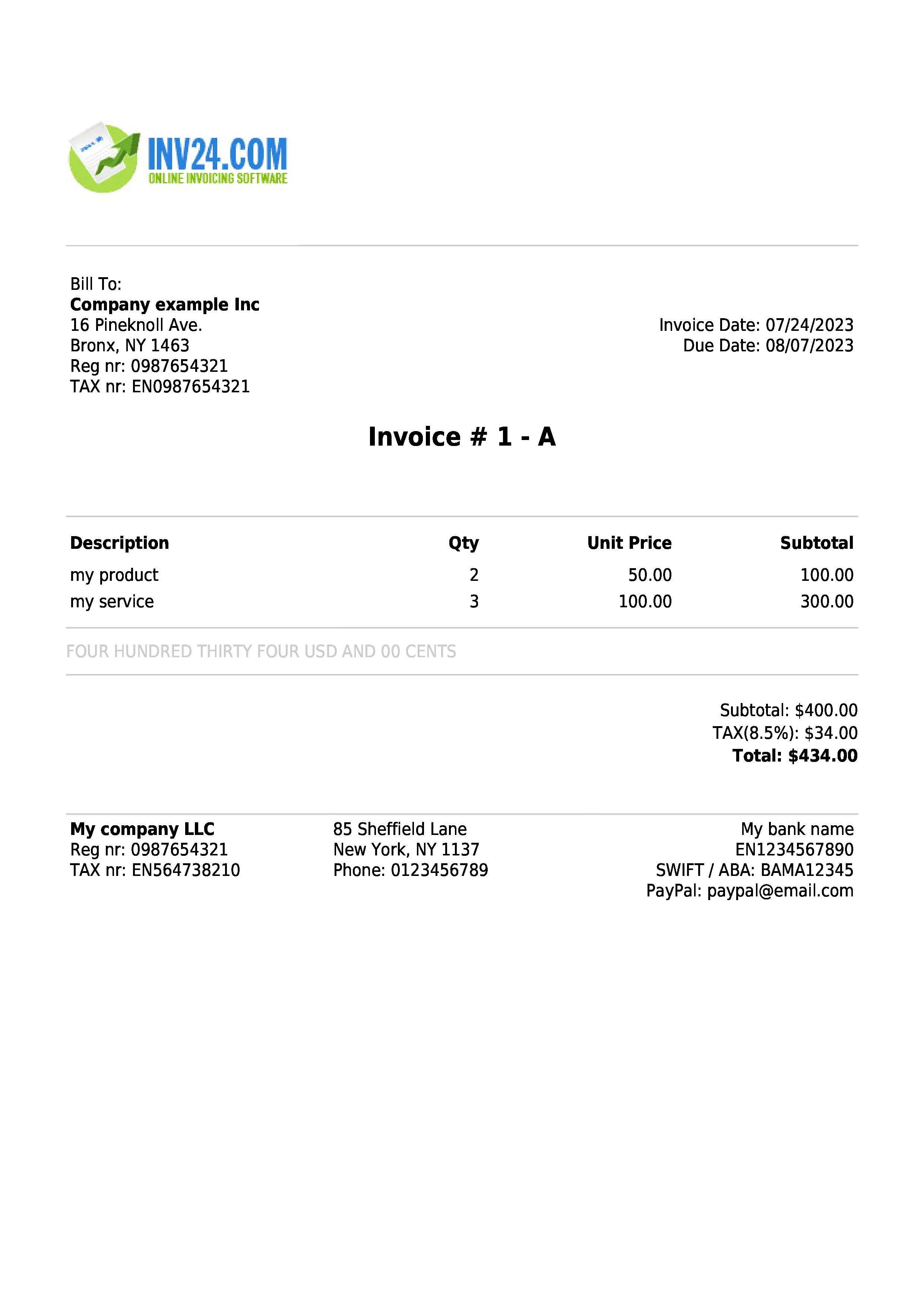Recurring invoice
What is a Recurring Invoice?
A recurring invoice is a special type of invoice which is produced by an invoice software that automatically creates and delivers invoices to subscription-based customers on a regular basis. Recurring invoices are extremely useful for businesses that have regular ongoing customers who have monthly, quarterly, or yearly subscriptions, as it saves time and also enables payments to be received faster.
Recurring Invoice Example
How to Create Recurring Invoices
Method 1: Use our simple invoice software
- Sign up and start your free 30 days trial period
- Set up your account
- Create recurring invoices
-

Recurring Invoice: An in-depth Explanation
Recurring Invoice Meaning
A recurring invoice is used by a business when a customer orders the same products or services on a regular basis, with the same terms and conditions. Although the time of the transaction can be different, it needs to be consistent and after a specific period.
A recurring invoice can be sent daily, weekly, monthly or as needed with a specific periodic frequency. On the recurring invoice, all content such as the product or service, client information and VAT/GST remain the same from period to period.
To effectively use the recurring invoice model, both parties (vendor and customer) must agree that there will be no change to the terms of trade. If there is a change of terms, then the recurring invoices will need to be updated to reflect those changes.
The main purpose of sending recurring invoices is to streamline the invoicing process while reducing the administrative burden on the team that manages the billing.
Let us explain by giving an example. Let us say that ABC Company provides security services to a commercial building which is under construction, at an agreed rate of $1500 a month. It is advantageous for ABC Company to use a recurring invoice as the terms, such as services, rates, and other details will most likely remain unchanged. In addition, there is most likely the need for security services to be provided for a longer period.
Detailed Explanation
Issuing invoices seem to be a fairly simple clerical process. However, a small error can have a significant impact on the overall business process. For better business efficacy, there is always a need to decrease the overall time for these processing functions.
A recurring invoice can be used when regular customers of the business order the same products or services on a regular basis and the content of this invoice is the same as the previous invoice. There should not be any changes to the specification or quantity of products, but as mentioned before, if there is a need, the recurring invoice can also be updated to reflect any changes.
Following are some situations where recurring invoices can be effective:
-
Rental for equipment
It is logical to use a recurring invoice in this situation, as equipment is typically rented for a longer term and invoiced monthly. Furthermore, the billing amount does not change frequently.
-
Monthly contract
In this situation, when goods or services are delivered or performed every month, this does not generally require any change to the amount of the goods or services. Using recurring invoices in this situation is advantageous as it eases bill management and invoicing tasks.
-
Membership fee
Using recurring invoices for membership fees is practical since membership fees are collected after regular intervals.
-
Maintenance and security services
Generally, maintenance is performed at regular intervals and similarly, security contracts are offered for longer regular periods. Usage of recurring invoices in these situations is a solid plan and this will lead to easier bill management processes.
If your company is based on a revenue model, such as a rental company, a security company, membership or periodic marketing company, then it will be ideal to use recurring invoices.
The content or information which is required to set up the recurring invoice is more than what you would typically need for a standard invoice. An added step is that you will need to set the invoice frequency when you set up the recurring invoice. The following content or information is required to set up the recurring invoice:
- The details of the customer.
- Agreed terms for price, quantity and others.
- Frequency of invoicing, sending options and other related information. In the invoice software, you can choose to set all the recurring invoices to be sent automatically. If approval is required before sending, the invoice software also has the ability to cater for this. This means that you will have the option of choosing to send a recurring invoice automatically or manually. Additionally, you can also have the ability to set seasonal invoicing.
Advantages of Using Recurring Invoices
Following are some advantages of using a recurring invoice:
- Clerical work which is managed by the billing department is greatly reduced, meaning that time is saved and costs are reduced. The reason for this is because the invoice software is set to automatically send and manage the invoices.
- Timely billing helps to ensure that the overall billing process is appropriately managed. This collection, on a timely basis, will enable the management of cash flow and will therefore help in the overall liquidity of the business.
- Since invoice software is highly accurate, the risk of under-invoicing decreases.
- Since the content of the invoice is replicated by the previous invoice automatically by using the invoice software, there will be less errors when recurring invoices are produced and sent.
- The use of recurring invoices can also directly impact the relationship that you have with your customer and clients. This is because neither party needs to worry about changing rates and other terms. These specifications are already decided upon. Invoices are always sent on a timely basis, without the risk of missing invoices. Thus, better business associations and relationships are formed which leaves a good professional impression on your customer.
- With the use of recurring invoices, timely and fast payments would be expected from your customer. Invoices are sent at the same time every period, for example the 1st of every month. The customer will become attune with your billing cycle and this will make them more likely to place your payment in priority to pay your invoices. Since the customer will know what payments are expected to be made every period, there will be sufficient time for the customer to make payment punctually.
- The consequence of having this timely payment from the customer, is that the recurring invoices will lead to an enhancement of the cash flow status of your business.
Disadvantages of using Recurring Invoices
Following are some disadvantages related to recurring invoices:
- Recurring invoices do not continue forever. There is a strong need to keep the customer engaged, otherwise the business may lose all its recurring revenue. What seems to be more challenging is to place close attention on customer retention and customer engagement.
- It may be difficult for the business to manage the influx of work. If the business is small and not able to be scalable, there will only be a limited use of the recurring invoice model.
- Preparing the recurring invoice module in the invoice software may prove to be costly. A cost-benefit analysis must be conducted before opting for this.
- There may be difficulty to ensure compliance with recurring invoices.
- If a customer switches to a different plan, the business may need to add to the current invoicing modules. This will lead to further costs.
- Coordination from a higher departmental level is required to successfully execute the recurring invoice model. Timely input is required from the sales department and technical departments executing the services.
Tips for Managing a Recurring Invoicing Model
The following tips can be useful in managing the system of a recurring invoice:
- Care needs to be taken to ensure that invoicing frequency is set accurately.
- Special attention must be taken to keep up to date with the VAT/GST rate. If there are changes in the VAT/GST rate, the system should immediately be updated to ensure accurate invoicing.
- It is wise to place some emphasis on customer engagement and continuing a good relationship with the customer. This will ensure that the system of recurring invoice will be long-lasting.
- Any change to the recurring invoice model should be backed by contractual authority. Changes in the recurring model must be reconciled with the contract.
Sample Email Template for Recurring Invoice
Hello {Name of the customer},
Your invoice # {XXX}, issued for our services for the period from {DATE} to {DATE}, is now due for payment. We expect the payment to be resolved within the next {DD} days so that we can ensure continued services and avoid any disruptions.
For your convenience, payment can be made by using the following payment details:
{Your payment details}
If you have any questions, please contact us at {Phone number / Email address}. We greatly value you as a customer and look forward to serving you with higher devotion and enthusiasm.
Best regards,
{Your name}
{Your position in the company}
{Your company name}
{Your contact details}
Conclusion
A business uses a recurring invoice when the same product or service are sold to and provided to a customer after regular intervals. This system is the backbone for the subscription membership based business. In order to use a recurring invoice model, the terms of the trade should remain fixed. If there is a change, this must be reflected in the accounting system.
Businesses that use the recurring invoice model include, but are not limited to, equipment rental, monthly contract services, membership, maintenance, security services and others.
There are many advantages to using recurring invoices such as, the reduction in times and cost for the billing department, improved cash flow status, enhanced relationship with customers, efficient payment collection and a reduction in the risk of under-invoicing.
However, there are notable challenges also. Such challenges are, the difficulty of managing an influx of services, ensuring customer satisfaction and engagement, and also the fact that a recurring invoice module may require a higher cost.
There are certain tips for managing a successful recurring invoice model. These tips include, appropriately setting invoice frequency, keeping updated on changes in tax policy, ensuring customer satisfaction and ensuring that there is the existence of contractual authority for any change in the recurring invoice terms.
Frequently Asked Questions
Which businesses should use recurring invoices?
It is appropriate for companies that bill customers after specific intervals to use the recurring invoice model. If there is consistent ongoing trade with customers on the same terms and conditions, then the recurring invoice model will be ideal to utilise.
How is automation related to recurring invoices?
The recurring invoice is related to automation because invoices with the same terms are sent out automatically each period to the customer. Hence, there is no necessity to frequently update the invoice content.
How is customer satisfaction related to recurring invoices?
Since invoices are sent out timely, without missing the date, it gives the impression that you are a professional and reliable service provider and business partner. This leads to greater customer satisfaction and will enhance the long term business relationship and association that you have with your customer.
Is it challenging to manage a recurring invoice model?
It may be challenging to manage a recurring invoice model. Certain businesses may not be capable of managing the influx of business brought about from the recurring invoice model. In addition, since circumstances constantly change, it may be tough to manage long term customer satisfaction and engagement.
Other Types of Invoices:
- Standard Invoice: standard invoice issued by a tax payer
- Invoice for tax non-payer: standard invoice issued by a tax non-payer company
- Proforma invoice: simple request for payment
- Credit note: refunding a customer
- Debit note: requesting a refund from a vendor

